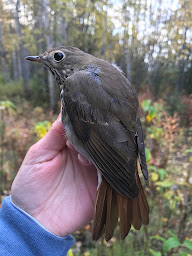 |
American Tree Sparrow
|
It was a beautiful fall morning today, and our first so far this week that we were able to get started on time. Suffice it to say, we've been ready for the rain to stop! Despite the bird activity in the vegetation around the station, our capture rate has dropped.
Without an exciting story from the day to tell you, I've decided to take another dive into bander jargon. Part 3 of the 'Bird Banding Jargon' series is themed after ageing and sexing characteristics or techniques. These are some of the "clues" we look for when trying to determine how old a bird is or whether it is male or female.
Brood Patch (BP): This is a naked patch of skin that is developed on the abdomen of a bird when they are incubating eggs and brooding young. Almost all female songbirds develop a brood patch, while some males (species dependent) might develop a partial brood patch. The presence of this complete brood patch in the spring reliably indicates that the bird is a female. Sometimes late nesting or individuals that complete multiple breeding attempts in a year may have a residual brood patch in the fall that allows us to determine sex.
Cloacal Protuberance (CP): During the breeding season a males cloaca distends from the body cavity to store viable sperm and assist with copulation. This distended cloaca is referred to as a cloacal protuberance. Similar to a brood patch, the presence of a cloacal protuberance during the breeding season allows a bander to determine the sex of an adult bird as male. Females do not develop cloacal protuberances.
Molt: This is the process of losing and growing in new feathers. Banders use known schedules of when birds are expected to replace certain feathers, and look for these patterns to determine the birds age. These schedules vary for each species, and are being increasingly used to verify and determine age of a bird. Stay tuned for a more in-depth conversation on molt!
Skulling: This is a technique that is currently the most reliable at ageing passerines during the fall. This process involves the bander gently parting the feathers over the posterior areas of the head to look through the skin (songbird skin is nearly clear!) to determine the level of skull pneumaticization. When songbirds fledge their skull is only composed of a single layer of bone; over their first year of life they will develop a second layer of bone under the first, a process called skull pneumaticization. The resulting air pockets and columns of support between the two layers are highly visible, and easily allow a bander to determine if a bird is an AHY or HY. AHY's will have completed the process of skull pneumaticization, and HY's will actively be in the process of skull pneumaticization which is seen as "windows" or "gaps" in the completed skull. It's kind of like a soft spots of a baby.
There is still so much we don't know about birds; even our most common captures including the most common warbler species in the U.S., the Yellow-rumped Warbler, are mystery when it comes to understanding whether they are male or female in the fall. When we examine a bird in the hand, a bander is considering a suite of evidence (with emphasis on the methods or characteristics above) and determining if it is conclusive enough to report with certainty how a bird is and its sex. Ageing birds in the fall for the species we capture is fairly straightforward and it's uncommon for us to be uncertain, but the exact opposite is true for determining sex! When we're uncertain, regardless of how we feel about what the answer might be, we often report age and sex as 'unknown' as it's of utmost importance to collect robust data. Plus, imagine how embarrassing it'd be for someone to recapture a bird you called a male as a female?!
Questions? Leave your questions in the comment sections and I'll respond with an answer!
~Claire






















